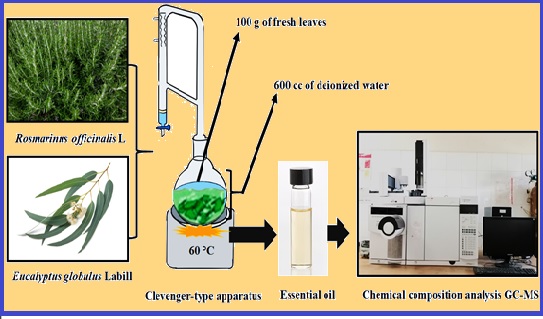Chemical analysis of Eucalyptus and Rosemary essential oils using gas chromatography-mass spectrometry (GC-MS) and evaluation of their toxicity against the most common urban pest
Volume 6, Issue 03, Pages 89-102, Sep 2023 *** Field: Analytical method in plant
Abstract
Using plant essential oils (EOs) as a pesticide alternative has gained increasing interest as a promising strategy to reduce the harmful effects of chemical pesticides. This study aims to investigate the chemical composition of Eucalyptus globulus Labill and Rosmarinus officinalis L. essential oils and evaluate their impacts against Blattella germanica L. under laboratory conditions. The essential oils were prepared from dried leaves using hydro-distillation (HD) as a chemical extraction method. The gas chromatography-mass spectrometry (GC-MS) was employed to analyze and identify their chemical compounds. Bioassays were conducted using the standard contact method recommended by the World Health Organization, and the data were analyzed using the probit regression model. By GC-MS analysis, the major components included 1,8-cineole (50.67%), alpha-pinene (17.48%), limonene (4.26%) for eucalyptus and alpha-pinene (20.67%), camphor (10.69%), 1,8-cineole (9.38%), Borneol (9.02%), comphene (7.15%), and limonene (4.88%) for rosemary. The LD50 values were 9. 27, 10.54, and 3.23 %, and LD95 values increased to 27.2, 22.3 %, and 14.3% for rosemary, eucalyptus, and their mixture. The EOs mixture had a higher repellent effect with a repellency rate of 98.9% at a concentration of 3% compared to 93.3% and 90% at a concentration of 5% for rosemary and eucalyptus alone.
References
R. Ye, K. Tian, Extraction process optimization of essential oil from Mellissa officinalis L. using a new ultrasound-microwave hybrid-assisted Clevenger hydrodistillation, Ind. Crops Prod., 203 ( 2023) 117165. https://doi.org/10.1016/j.indcrop.2023.117165
F. Chen, X. Du, A new approach for preparation of essential oil, followed by chlorogenic acid and hyperoside with microwave-assisted simultaneous distillation and dual extraction (MSDDE) from Vaccinium uliginosum leaves, Ind. Crops Prod., 77 ( 2015) Pages 809-826. https://doi.org/10.1016/j.indcrop.2015.09.058
M. M. Tavakoli, B. Davari, H. Nasirian, A. Salehzadeh, S. Moradkhani, A. H. Zahirnia, Investigation of insecticidal properties of Rosmarinus officinalis L. and Lavandula angustifolia Mill essential oils against German cockroach in laboratory conditions, Feyz Med. Sci. J., 25 (2021) 994-1002. https://feyz.kaums.ac.ir/article-1-4254-en.html
A. Kakeh-Khani, M. Nazari, H. Nasirian, Insecticide resistance studies on German cockroach (Blattella germanica) strains to malathion, propoxur and lambdacyhalothrin, Chula Med. J., 64 (2020) 357-365. https://doi.org/10.14456/clmj.2020.45
C.A. Damalas, I.G. Eleftherohorinos, Pesticide exposure, safety issues, and risk assessment indicators, Int. J. Env. Res.pub. Health, 8 (2011) 1402-1419. https://doi.org/10.3390/ijerph8051402
X.Y. Pan, F. Zhang, Advances in biological control of the German cockroach, Blattella germanica (L.), Biol. Control, 142 (2020) 104104. https://doi.org/10.1016/j.biocontrol.2019.104104
Y.C. Yang, H.S. Lee, J.M. Clark, Y.J. Ahn, Insecticidal activity of plant essential oils against Pediculus humanus capitis (Anoplura: Pediculidae), J. Med. Entomol., 41 (2004) 699-704. https://doi.org/10.1603/0022-2585-41.4.699
A. Bolandnazar, M. Ghadamyari, M. Memarzadeh, J. Jalali Sandi, Repellent and lethal effect of essential oils of rosemary, peppermint and eucalyptus and thyme extract, formulated as nano-and microemulsions, on Bemisia tabaci (Homoptera: Aleyrodidae) under greenhouse condition, J. Entomol. Soc. Iran., 38 (2018) 81-97. https://doi.org/10.22117/jesi.2018.116014.1152
M. Sharififard, F. Safdari, A. Siahpoush, H. Kassiri, Insecticidal and Repellency properties of Eucalyptus sp. essential oil against Supella longipalpa (Dictyoptera: Blatellidae), an important vector of tropical and infectious diseases, in hospitals and residential areas, Iran. J. Infect. Dis., 19 (2014) 67-71. http://www.iiccom.org/current_issue.asp
C. D. Zhang, X. Y. Hu, H. S. Wang, GC–MS analysis of essential oil extracted from Acori tatarinowii Rhizoma: An experiment in natural product analysis, J. Chem. Educ., 98 (2021) 3004–3010. https://doi.org/10.1021/acs.jchemed.1c00451
B. Obi Johnson, A. M. Golonka, Determination of Linalool in essential oils by SPME-GC-MS: Using the internal standard method, J. Chem. Educ., 99 (2022) 917–923. https://doi.org/10.1021/acs.jchemed.1c00212
S. Gaire, M. E. Scharf, A. D. Gondhalekar, Synergistic toxicity interactions between plant essential oil components against the common bed bug (Cimex lectularius L.), Insects, 11 (2020) 133. https://doi.org/10.3390/insects11020133
A. Ebadollahi, W.N. Setzer, Analysis of the essential oils of Eucalyptus camaldulensis Dehnh. and E. viminalis Labill. as a contribution to fortify their insecticidal application, Nat. Prod. Commun., 15 (2020) 1-10. https://doi.org/ 10.1177/1934578X20946248
R. Pavela, G. Benelli, Essential oils as ecofriendly biopesticides? challenges and constraints, Trends plant Sci., 21 (2016) 1000–1007. https://doi.org/10.1016/j.tplants.2016.10.005
L. Wuv, X. Huo, X. Zhou, D. Zhao, W. He, S. Liu, H. Liu, T. Feng, C. Wang, Acaricidal activity and synergistic effect of thyme oil constituents against carmine spider mite (Tetranychus Cinnabarinus (Boisduval), Molecules, 22 (2017) 1873. https://doi.org/10.3390/molecules22111873
R. Pavela, Essential oils for the development of eco-friendly mosquito larvicides: a review, Ind. Crops Prod., 76 (2015) 174-187. https://doi.org/10.1016/j.indcrop.2015.06.050
M. B. Isman, M. L. Grieneisen, Botanical insecticide research: many publications, limited useful data, Trends Plant Sci., 19 (2014) 140-145. https://doi.org/10.1016/j.tplants.2013.11.005
S. Shi, X. Zhang, X. Liu, Z. Chen, H. Tang, D. Hu, H. Li, GC-MS analysis of the essential oil from Seseli mairei H. Wolff (Apiaceae) roots and their nematicidal activity, Molecules, 28 (2023) 2205. https://doi.org/10.3390/molecules28052205
C. Regnault-Roger, C. Vincent, J.T. Arnason, Essential oils in insect control: low-risk products in a high-stakes world, Annu. Rev. Entomol., 57 (2012) 405-424. https://doi.org/10.1146/annurev-ento-120710-100554
WHO, Instructions for determining the susceptibility or resistance of adult mosquitos to organochlorine, organophosphate and carbamate insecticides: diagnostic test, WHO/VBC/81.806. Geneva: World Health Organization,1981. https://apps.who.int/iris/handle/10665/69615
Z. Karamzadeh, J. Rakhtshah, N.M. Kazemi, A novel biostructure sorbent based on ysSB/MetSB@ MWCNTs for separation of nickel and cobalt in biological samples by ultrasound assisted-dispersive ionic liquid-suspension solid phase micro extraction, J. Pharm. Biomed. Anal., 172 (2019) 285-294. https://doi.org/10.1016/j.jpba.2019.05.003
K. Merchant, M.D. Mobarake, Ultrasound-assisted solid-liquid trap phase extraction based on functionalized multi wall carbonnanotubes for preconcentration and separation of nickel in petrochemical wastewater, J. Anal. Chem., 74 (2019) 865-876. https://doi.org/10.1134/S1061934819090090
N. Esmaeili, Ultrasound assisted-dispersive-modification solid-phase extraction using task-specific ionic liquid immobilized on multiwall carbon nanotubes for speciation and determination mercury in water samples, Microchem. J., 154 (2020) 104632. https://doi.org/10.1016/j.microc.2020.104632
J. Rakhtshah, N. Esmaeili, A rapid extraction of toxic styrene from water and wastewater samples based on hydroxyethyl methylimidazolium tetrafluoroborate immobilized on MWCNTs by ultra-assisted dispersive cyclic conjugation-micro-solid phase extraction, Microchem. J., 170 (2021) 106759. https://doi.org/10.1016/j.microc.2021.106759
M. Habibnia, A. Rashidi, Simultaneously speciation of mercury in water, human blood and food samples based on pyrrolic and pyridinic nitrogen doped porous graphene nanostructure, Food Chem., 403 (2023) 134394. https://doi.org/10.1016/j.foodchem.2022.134394
N. Esmaeili, J. Rakhtshah, E. Kolvari, Rapid speciation of lead in human blood and urine samples based on mwcnts@ dmp by dispersive ionic liquid-suspension-micro-solid phase extraction, Biol. Trace Elem. Res., 199 (2021) 2496-2507. https://doi.org/ 10.1007/s12011-020-02382-7
Sh. Teimoori, New extraction of toluene from water samples based on nano-carbon structure before determination by gas chromatography, Int. J. Environ. Sci. Technol., 20 (2023) 6589–6608. https://doi.org/10.1007/s13762-023-04906-9
A. Tawatsin , S. D. Wratten, R. R. Scott, U. Thavara, Repellency of volatile oils from plants against three mosquito vectors, J. Vector Ecol, 26 (2001) 76-82. https://onlinelibrary.wiley.com/journal/19487134
S. S. Cheng, H.T. Chang, S. T. Chang, K. H. Tsai, W. J. Chen, Bioactivity of selected plant essential oils against the yellow fever mosquito Aedes aegypti larvae, Bioresour. Technol., 89 (2003) 99-102. https://doi.org/10.1016/S0960-8524(03)00008-7
V.A. Cruz, N.J. Ferreira, H.P. Cornelio-Santiago, Oil extraction from black soldier fly (Hermetia illucens L.) larvae meal by dynamic and intermittent processes of supercritical CO2 – Global yield, oil characterization, and solvent consumption, J. Supercrit. Fluids, 195 (2023) 105861. https://doi.org/10.1016/j.supflu.2023.105861
W.S. Choi, B.S. Park, S.K. Ku, S.E. Lee, Repellent activities of essential oils and monoterpenes against Culex pipiens pallens, J. Am. Mos. Control. Assoc., 18 (2002) 348-351. https://pubmed.ncbi.nlm.nih.gov/12542193/
R. Pavela, Insecticidal properties of several essential oils on the house fly (Musca domestica L.), Pest. Manag. Sci., 22 (2007) 274-278. https://doi.org/10.1002/ptr.2300
E. Enan, Insecticidal activity of essential oils: octopaminergic sites of action, Comparative Biochemistry and Physiology Part C: Toxicology & Pharmacology, 130 (2001) 325-337. https://doi.org/10.1016/S1532-0456(01)00255-1
K. Huang, D. Zhang, J. J. Ren, Screening of the repellent activity of 12 essential oils against adult German Cockroach (Dictyoptera: Blattellidae): preparation of a sustained release repellent agent of binary Oil-γ-CD and its repellency in a small container, J. Econ. Entomol., 113 ( 2020) 2171–2178., https://doi.org/10.1093/jee/toaa162
C. J. Peterson, J. R. Coats, Catnip essential oil and its nepetalactone isomers as repellents for Mosquitoes, Recent Developments in Invertebrate Repellents, ACS publisher, Chapter 4, pp 59-65, 2011. https://doi.org/10.1021/bk-2011-1090.ch004
O. Koul, S. Walia, G. S. Dhaliwal, Essential oils as green pesticides: potential and constraints. Biopestic. Int., 4 (2008) 63-84. https://www.koulresearch.org/journal.htm
R. Jannatan, R. Rahayu, Fumigant toxicity and repellency of citronella grass essential oil (Cymbopogon nardus (L.) Rendle) to German cockroaches (Blattella germanica L.), Eur. J. Biol. Res., 11(2021) 267-273. http://dx.doi.org/10.5281/zenodo.4670508
R. Nikzad, M.R. Youssefi, Comparison of lethal effect of carvacrol, thymol, permethrin and cypermethrin toxicants on German cockroaches (Blattella germanica), Vet. Res. Biol. Prod., 131 (2021) 61-67. https://doi.org/ 10.22092/VJ.2020.128751.1671
A. K. Phillips, A.G. Appel, Fumigant toxicity of essential oils to the German cockroach (Dictyoptera: Blattellidae), J. Econ. Entomol., 103 (2010) 781-90. https://doi.org/ 10.1603/ec09358.
I. Zibaee, P. Bahari Khorra, Synergistic effect of some essential oils on toxicity and knockdown effects, against mosquitos, cockroaches and housefly, Arthropods, 4 (2015) 107-123. http://www.iaees.org/publications/journals/arthropods/articles/2015-4(4)/2015-4(4).asp

Copyright (c) 2023 Analytical Methods in Environmental Chemistry Journal

This work is licensed under a Creative Commons Attribution 4.0 International License.
JOURNAL PUBLISHING AGREEMENT
PLEASE PROVIDE US THE FOLLOWING INFORMATION,
Article entitled:
Corresponding author:
To be published in the journal:
Your Status
I am the sole author of the manuscript
- I am an Iranian government employee.
- I am a European government employee
- I am a Asian government
- None of the above
I am one author signing on behalf of all co-authors of the manuscript
- I am an Iranian government employee.
- I am a European government employee
- I am a Asian government
- None of the above
Please tick the above blanks (as appropriate), review the Journal Publishing Agreement, and then sign and date the document in black ink.
Published Journal Article: the author may share a link to the formal publication through the relevant DOI. Additionally theses and dissertations which contain embedded Published Journal Articles as part of the formal submission may be hosted publicly by the awarding institution with a link to the formal publication through the relevant DOI. Any other sharing of Published Journal Articles is by agreement with the publisher only.
Signed: ______________________________________ Name printed: ___________________________________________
Title and Company (if employer representative): _______________________Date: __________________________________














